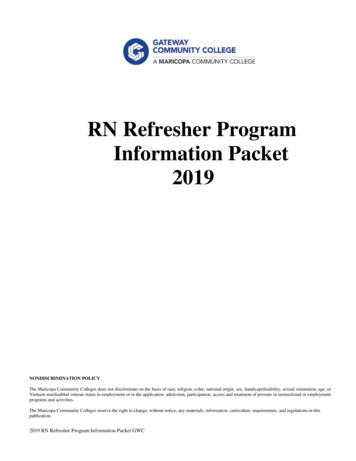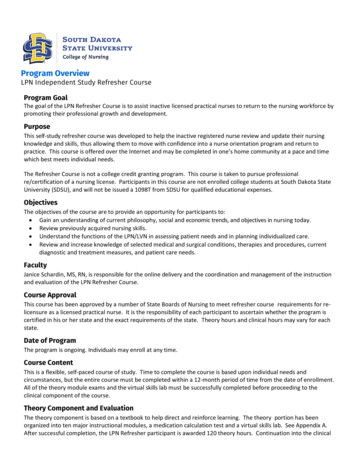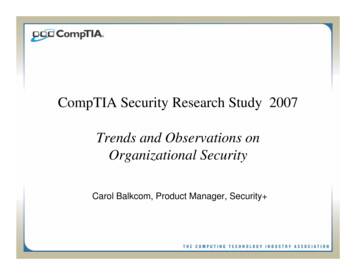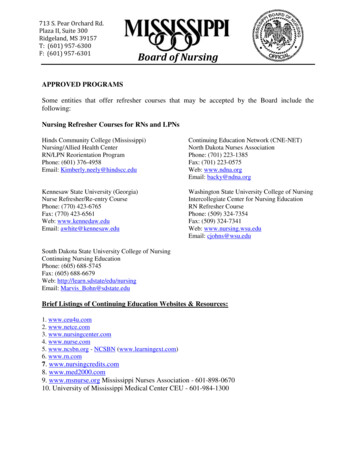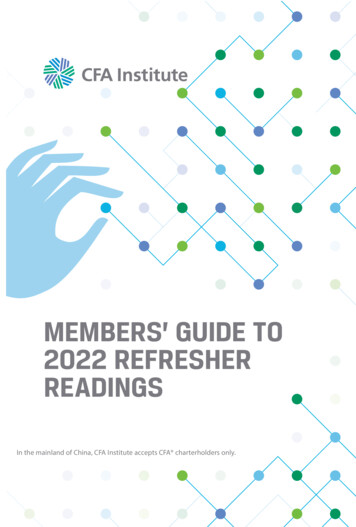
Transcription
MEMBERS’ GUIDE TO2022 REFRESHERREADINGSIn the mainland of China, CFA Institute accepts CFA charterholders only.
MEMBERS’ GUIDE TO2022 REFRESHERREADINGSIn the mainland of China, CFA Institute accepts CFA charterholders only.
2021 CFA Institute. All rights reserved.This copyright covers material written expressly for this volume bythe editor/s as well as the compilation itself. It does not cover theindividual selections herein that first appeared elsewhere. Permissionto reprint these has been obtained by CFA Institute for this editiononly. Further reproductions by any means, electronic or mechanical,including photocopying and recording, or by any information storageor retrieval systems, must be arranged with the individual copyrightholders noted.CFA , Chartered Financial Analyst , AIMR-PPS , and GIPS are just afew of the trademarks owned by CFA Institute. To view a list of CFAInstitute trademarks and the Guide for Use of CFA Institute Marks,please visit our website at www.cfainstitute.org.This publication is designed to provide accurate and authoritativeinformation in regard to the subject matter covered. It is sold withthe understanding that the publisher is not engaged in renderinglegal, accounting, or other professional service. If legal advice or otherexpert assistance is required, the services of a competent professionalshould be sought.All trademarks, service marks, registered trademarks, and registeredservice marks are the property of their respective owners and are usedherein for identification purposes only.In the mainland of China, CFA Institute accepts CFA charterholdersonly.ISBN 978-1-953337-14-610 9 8 7 6 5 4 3 2 1
ContentsForeword1Environmental, Social, and Governance Issues3What Is Changing in the 2022 Curriculum?Why Does It Matter to Members?Environmental, Social, and Governance (ESG)Considerations in Investment AnalysisLearning OutcomesIntroductionSummaryIntroduction to Corporate Governance and Other ESGConsiderationsLearning OutcomesIntroductionSummaryBasics of Portfolio Planning and ConstructionLearning s25What Is Changing in the 2022 Curriculum?Why Does It Matter to Members?Ethics ApplicationLearning OutcomesIntroduction26282929297789
ContentsAlternative Investments31What Is Changing in the 2022 Curriculum?Why Does It Matter to Members?Introduction to Alternative InvestmentsLearning OutcomesIntroductionSummaryReal Estate InvestmentsLearning OutcomesIntroductionSummaryIntegrated Cases in Risk Management: InstitutionalLearning tal and Corporate Issuers55What Is Changing in the 2022 Curriculum?Why Does It Matter to Members?Sources of CapitalLearning OutcomesIntroductionSummaryUses of CapitalLearning OutcomesIntroductionSummaryCapital StructureLearning 46566iv Members’ Guide to 2022 Refresher Readings
ContentsInvestment Analysis Techniques69What Is Changing in the 2022 Curriculum?Why Does It Matter to Members?Hypothesis TestingLearning OutcomesIntroductionSummaryIntroduction to Linear RegressionLearning OutcomesIntroductionSummaryProbability ConceptsLearning OutcomesIntroductionSummaryCommon Probability DistributionsLearning OutcomesIntroductionSummarySampling and EstimationLearning 8899096969899104104105106Fixed Income111What Is Changing in the 2022 Curriculum?Why Does It Matter to Members?Yield Curve StrategiesLearning OutcomesIntroductionSummary113114115115116117 2021 CFA Institute. All rights reserved.v
ContentsFixed-Income Active Management: Credit StrategiesLearning OutcomesIntroductionSummaryThe Term Structure and Interest Rate DynamicsLearning OutcomesIntroductionSummaryvi 121121122123127127128129Members’ Guide to 2022 Refresher Readings
ForewordLet’s get practicalWe know from your feedback that our members value RefresherReadings. We strive every year to make these Refresher Readingsmore targeted and to deliver the knowledge and insight that members seek to remain competent investment professionals.Our aim is to increase the relevance of the CFA Program, putting the real-life, day-to-day experience of investment professionalsat the heart of the curriculum. And this approach does not applysolely to the curriculum. We plan to expand our portfolio of learning offerings, providing investment professionals who seek to upskilland reskill with high-quality practitioner-relevant content that canbe integrated into their workflow.We have introduced many new readings and revisions to the2022 curriculum, adding to the large number of improvements madein recent years to respond to changing investment markets and practices. We have streamlined readings, making them more accessiblethrough more engaging narratives and with the improved use ofvisual aids and practical examples.The key changes in the 2022 curriculum broadly fall into sixcategories: Environmental, Social, and Governance (ESG); Ethics;Alternative Investments; Corporate Issuers; Investment Analysis; andFixed Income: The evolving approach to ESG focuses on analysis of how wellcompanies fare from an ESG standpoint. Innovative new content sets out, for example, possible approaches used to identify acompany’s, or an industry’s, material ESG risks. Brand-new ethics content, inspired by actual events, illustratesmany aspects of the CFA Institute Code of Ethics and Standards 2021 CFA Institute. All rights reserved.1
Forewordof Professional Conduct. This content makes it intuitive to identify scenarios that apply to your particular area of interest. Growing investor focus on alternative investments has led toan expansion of this topic in the curriculum, with new readingsdemonstrating how alternatives may be deployed in a portfolio. Foundational knowledge is combined with exploration ofhow alternative asset classes, risk management, and alternativeinvestment structures work. Substantial new content focusing on corporate issuers presentsthe choices a company makes when raising and using capital.Many practical examples and explanations illustrate why andhow companies’ capital choices vary over their lifecycles. Investment analysis techniques are always evolving, and severalreadings contain substantial new content on quantitative methods, thereby aligning the curriculum more closely to investmentprofessionals’ experience of an artificial intelligence–drivenworld. The focus is resolutely on the practical, with engagingvisuals and code snippets. Finally, in an era of low interest rates, members will want toknow how fixed-income portfolios are managed by their peers.New content on yield curve and credit strategies, as well as interest rate dynamics, offers valuable and practical insight.I hope these Refresher Readings are genuinely useful in your work.We welcome your feedback and wish you every success.You can reach us at professionallearning@cfainstitute.org.Barbara S. Pécherot Petitt, PhD, CFA,Managing Director, Professional Learning2 Members’ Guide to 2022 Refresher Readings
Environmental,Social, andGovernance IssuesApplicable ReadingsEnvironmental, Social, and Governance (ESG) Considerations inInvestment Analysis (Level II)By Deborah S. Kidd, CFA, Young Lee, CFA, JD, and Johan Vanderlugt2 PL creditsAccess the full reading: cfainst.is/esgconsiderationsIntroduction to Corporate Governance and Other ESGConsiderations (Level I)By Assem Safieddine, PhD, Young Lee, CFA, Donna F. Anderson, CFA,Deborah S. Kidd, CFA, and Hardik Sanjay Shah, CFA1.5 PL creditsAccess the full reading: cfainst.is/corpgovandesgBasics of Portfolio Planning and Construction (Level I)By Alistair Byrne, PhD, CFA and Frank E. Smudde, MSc, CFA1.5 PL creditsAccess the full reading: cfainst.is/portfolioplanning 2021 CFA Institute. All rights reserved.3
What Is Changing in the2022 Curriculum?The CFA Program curriculum has evolved from treating environmental, social, and governance (ESG) issues as an internal corporate governance issue to placing the emphasis squarely on external analysisof companies’ ESG activities. This innovation brings CFA Instituteand its members to the forefront of investment thinking, in whichESG is a core component of investment analysis.The revised reading “Environmental, Social, and Governance(ESG) Considerations in Investment Analysis” represents this refocused approach as well as the current thinking of the CFA InstituteESG Working Group. The reading presents a new case showing howfirms can execute climate change scenario planning and incorporatesa user-friendly exhibit setting out an ESG Integration Framework.The ESG Integration Framework shows how qualitative andquantitative research are key elements of an ESG strategy. Securitiesvaluation, portfolio construction, asset allocation, scenario analysis,and risk management form the remainder of the framework.In the associated case, we see how a well-crafted sustainabilityreport by City Developments Limited (CDL) better prepares itsbusiness for the potential financial impacts of the physical andtransition risks of climate change. We also see how CDL repositionsits ESG activities to comply with the recommendations of the TaskForce on Climate-related Financial Disclosures (TCFD) and theIntergovernmental Panel on Climate Change (IPCC). A systematicand holistic approach is used to assess and quantify all potentialimpacts on CDL’s portfolio from climate-related risks andopportunities.4 Members’ Guide to 2022 Refresher Readings
What Is Changing in the 2022 Curriculum?The updated reading “Introduction to Corporate Governance andOther ESG Considerations” has substantial new content, includinganother useful framework to guide analysts in their everyday work.This framework incorporates and explains six key ESG investmentapproaches: negative screening, positive screening, ESG integration,thematic investing, engagement/active ownership, and impact investing. New material on environmental and social aspects of ESG is provided in the reading as well as a discussion of ESG issues from microand macro perspectives.Additionally, how investment professionals integrate ESG intoportfolio construction is explored in the updated reading “Basics ofPortfolio Planning and Construction.” 2021 CFA Institute. All rights reserved.5
Why Does It Matter toMembers?With no globally accepted best practice for ESG integration, analysts must decide for themselves the materiality of ESG-related data.“Environmental, Social, and Governance (ESG) Considerations inInvestment Analysis” explains how investment professionals candetermine whether ESG-related factors are relevant to a companyand identify applicable qualitative and quantitative data.This reading sets out possible approaches used to identify acompany’s, or an industry’s, material ESG factors, using proprietarymethods, ratings, and analysis from ESG data providers, and not-forprofit industry initiatives and sustainability reporting frameworks.“Introduction to Corporate Governance and other ESGConsiderations” assists practitioners in assessing the efficacy of a company’s corporate governance structure and controls, including consideration of conflicts of interest and transparency of operations. This readingillustrates how increased data availability has increased the weight ofcorporate governance in the investment decision-making process.The integration of ESG factors changes the portfolio construction process. ESG analysis affects both strategic asset allocation andimplementation, and thus requires rethinking by investment managers in terms of the selection of securities, the exercise of shareholderrights, and the devising of investment strategies. “Basics of PortfolioPlanning and Construction” serves as a guide for the integrationof ESG and focuses on key factors, including scarcity of naturalresources, physical impacts of climate change, global economic anddemographic trends, diversity and inclusion, and the rise of socialmedia.6 Members’ Guide to 2022 Refresher Readings
Environmental, Social,and Governance (ESG)Considerations inInvestment AnalysisDeborah S. Kidd, CFA, Young Lee, CFA, JD, and Johan VanderlugtDeborah S. Kidd, CFA, is at CFA Institute (USA). Young Lee, CFA,JD, is at MacKay Shields (USA and Europe), MacKay Shields EuropeInvestment Management Ltd. (Ireland), and MacKay Shields UK LLP(United Kingdom). Johan Vanderlugt is at NN Investment Partners(Netherlands).CFA Institute would like to thank Hardik Sanjay Shah, CFA, for his contributions to the 2022 update of this reading.Learning OutcomesThe candidate should be able to:a.describe global variations in ownership structures and the possible effects of these variations on corporate governance policiesand practices;b.evaluate the effectiveness of a company’s corporate governancepolicies and practices;c.describe how ESG-related risk exposures and investment opportunities may be identified and evaluated; and 2021 CFA Institute. All rights reserved.7
Environmental, Social, and Governance Issuesd.evaluate ESG risk exposures and investment opportunitiesrelated to a company.IntroductionEnvironmental, social, and governance (ESG) considerations areincreasingly being integrated into investment analysis. Evaluatinghow ESG factors potentially affect a company may provide analystswith a broader perspective on the risks and investment opportunities of a company’s securities. Although corporate governance haslong been recognized as having a significant impact on a company’slong-term performance, investors have become increasingly concerned with environmental and social factors as well as how companies manage their resources and risk exposures that relate to suchfactors. Mismanagement of these resources has led to a number ofhigh-profile corporate events that have negatively affected securityprices. Increasingly stringent regulatory environments, potentiallyfinite supplies of natural resources, and global trends toward energyconservation and waste reduction have led many investors to placea greater emphasis on the management of environmental risks.Similarly, such issues as worker health and safety policies, community impact, and marketing practices have increased the visibility ofhow a company manages its social capital.This reading provides an overview of ESG considerations ininvestment analysis. Section 2 provides an overview of the globalvariations in corporate ownership structures, as well as how theseownership structures may affect corporate governance outcomes. InSection 3, we discuss company-specific factors that should be considered when evaluating corporate governance in the investment8 Members’ Guide to 2022 Refresher Readings
ESG Considerations in Investment Analysisprocess. Section 4 discusses the identification of ESG-related risksand opportunities that are relevant to security analysis. Section 5demonstrates the evaluation of ESG-related risks and opportunitiesthrough several examples. The reading concludes with a summary ofthe key points discussed.Summary Shareholder ownership structures are commonly classified asdispersed, concentrated, or a hybrid of the two. Dispersed ownership reflects the existence of many shareholders,none of which, either individually or collectively, has the abilityto exercise control over the corporation. Concentrated corporateownership reflects an individual shareholder or a group (controlling shareholders) with the ability to exercise control over thecorporation. Controlling shareholders may be either majority shareholders orminority shareholders. Horizontal ownership involves companies with mutual business interests that have cross-holding share arrangements witheach other. Vertical (or pyramid) ownership involves a companyor group that has a controlling interest in two or more holdingcompanies, which in turn have controlling interests in variousoperating companies. Dual-class (or multiple-class) shares grant one or more shareclasses superior or even sole voting rights, whereas other shareclasses have inferior or no voting rights. 2021 CFA Institute. All rights reserved.9
Environmental, Social, and Governance Issues Types of influential owners include banks, families, sovereigngovernments, institutional investors, group companies, privateequity firms, foreign investors, managers, and board directors. A corporation’s board of directors is typically structured as eitherone tier or two tier. A one-tier board consists of a single boardof directors, composed of executive (internal) and nonexecutive(external) directors. A two-tier board consists of a supervisoryboard that oversees a management board. CEO duality exists when the chief executive officer also serves asthe board chair. A primary challenge of integrating ESG factors into investmentanalysis is identifying and obtaining information that is relevant,comparable, and decision-useful. ESG information and metrics are inconsistently reported bycompanies, and such disclosure is voluntary, which providesadditional challenges for analysts. In an ESG context, materiality typically refers to ESG-relatedissues that are expected to affect a company’s operations orfinancial performance and the valuation of its securities. Corporate governance considerations, such as the structure ofthe board of directors, tend to be reasonably consistent acrossmost companies. In contrast, environmental and social considerations often differ greatly. Analysts typically use three main sources of information toidentify a company’s (or industry’s) ESG factors: (1) proprietaryresearch, (2) ratings and analysis from ESG data providers, or(3) research from not-for-profit industry organizations andinitiatives.10 Members’ Guide to 2022 Refresher Readings
ESG Considerations in Investment Analysis In equity analysis, ESG integration is used to both identifypotential opportunities and mitigate downside risk, whereas infixed-income analysis, ESG integration is generally focused onmitigating downside risk. A typical starting point for ESG integration is the identificationof material qualitative and quantitative ESG factors that pertainto a company or its industry. 2021 CFA Institute. All rights reserved.11
Introduction to CorporateGovernance and Other ESGConsiderationsAssem Safieddine, PhD, Young Lee, CFA, Donna F. Anderson,CFA, Deborah S. Kidd, CFA, and Hardik Sanjay Shah, CFAAssem Safieddine, PhD, is at Suliman Olayan Business School,American University of Beirut (Lebanon). Young Lee, CFA, is atMacKay Shields LLC (USA), MacKay Shields Europe InvestmentManagement Ltd. (Ireland), and MacKay Shields UK LLP (UnitedKingdom). Donna F. Anderson, CFA (USA). Deborah S. Kidd, CFA, isat CFA Institute (USA). Hardik Sanjay Shah, CFA, is at GMO LLC(Singapore).Learning OutcomesThe candidate should be able to:a.describe corporate governance;b.describe a company’s stakeholder groups, and compare interestsof stakeholder groups;c.describe principal–agent and other relationships in corporate governance and the conflicts that may arise in theserelationships;d.describe stakeholder management;12 Members’ Guide to 2022 Refresher Readings
Introduction to Corporate Governance and Other ESG Considerationse.describe mechanisms to manage stakeholder relationships andmitigate associated risks;f.describe functions and responsibilities of a company’s board ofdirectors and its committees;g.describe market and nonmarket factors that can affectstakeholder relationships and corporate governance;h.identify potential risks of poor corporate governance andstakeholder management, and identify benefits from effectivecorporate governance and stakeholder management;i.describe factors relevant to the analysis of corporate governanceand stakeholder management;j.describe environmental and social considerations in investmentanalysis; andk.describe how environmental, social, and governance factors maybe used in investment analysis.IntroductionWeak corporate governance is a common thread found in manycompany failures. Lack of proper oversight by the board of directors,inadequate protection for minority shareholders, and incentives atcompanies that promote excessive risk taking are just a few of theexamples that can be problematic for a company. Poor corporategovernance practices have resulted in several high-profile accountingscandals and corporate bankruptcies over the past several decadesand have been cited as significantly contributing to the 2008–2009global financial crisis. 2021 CFA Institute. All rights reserved.13
Environmental, Social, and Governance IssuesIn response to these failures, regulations have been introducedto promote stronger governance practices to protect financial markets and investors. Academics, policy makers, and other groups havepublished numerous works discussing the benefits of good corporategovernance and identifying core corporate governance principlesbelieved to be essential to ensuring continuous, well-functioningcapital markets and the stability of the financial system.The investment community also has demonstrated a greaterappreciation for the importance of good corporate governance. Theassessment of a company’s corporate governance structure andcontrols, including consideration of conflicts of interest and transparency of operations, has been an essential factor in investmentanalysis. More data availability and demands for better governancehave increased the weight of corporate governance in the investmentdecision-making process. In addition, investors have become moreattentive to environmental and social issues related to a company’soperations. Collectively, these concepts often are referred to as environmental, social, and governance (ESG).Section 1 of this reading provides an overview of corporate governance, including its underlying principles and theories. Section 2discusses the various stakeholders of a company and conflicts ofinterest that exist among stakeholder groups. Section 3 describes theprincipal–agent and other relationships in corporate governance andthe conflicts that may arise in these relationships. Section 4 describesstakeholder management, reflecting how companies manage theirrelationships with stakeholders. Section 5 focuses on mechanismsto manage stakeholder relationships and mitigate associated risks.Section 6 focuses on the role of the board of directors and its committees as overseers of the company. Section 7 explores certainkey factors that affect stakeholder relationships and corporate governance. Section 8 highlights the risks and benefits that underlie acorporate governance structure. Section 9 synthesizes corporate14 Members’ Guide to 2022 Refresher Readings
Introduction to Corporate Governance and Other ESG Considerationsgovernance concepts that should be considered by investment professionals. Finally, Section 10 discusses the growing use of ESG factorsin investment analysis and portfolio construction processes.SummaryThe investment community has increasingly recognized the importance of corporate governance as well as environmental and socialconsiderations. Although practices concerning corporate governance(and ESG overall) will undoubtedly continue to evolve, investmentanalysts who have a good understanding of these concepts can better appreciate the implications of ESG considerations in investmentdecision making. The core concepts covered in this reading are asfollows: Corporate governance can be defined as a system of controls andprocedures by which individual companies are managed. Of the many systems of corporate governance, most reflect theinfluences of either shareholder theory or stakeholder theory, orboth. Current trends, however, point to increasing convergence. A corporation’s governance system is influenced by several stakeholder groups, and the interests of the groups often diverge orconflict. The primary stakeholder groups of a corporation consist ofshareholders, creditors, managers and employees, the board ofdirectors, customers, suppliers, and government/regulators. A principal–agent relationship (or agency relationship) entails aprincipal hiring an agent to perform a particular task or service. 2021 CFA Institute. All rights reserved.15
Environmental, Social, and Governance IssuesIn a corporate structure, such relationships often lead to conflicts among various stakeholders. Stakeholder management involves identifying, prioritizing, andunderstanding the interests of stakeholder groups and on thatbasis managing the company’s relationships with stakeholders.The framework of corporate governance and stakeholder management reflects a legal, contractual, organizational, and governmental infrastructure. Mechanisms of stakeholder management may include generalmeetings, a board of directors, the audit function, companyreporting and transparency, related-party transactions, remuneration policies (including say on pay), and other mechanismsto manage the company’s relationship with its creditors, employees, customers, suppliers, and regulators. A board of directors is the central pillar of the governance structure, serves as the link between shareholders and managers, andacts as the shareholders’ internal monitoring tool within thecompany. The structure and composition of a board of directors vary acrosscountries and companies. The number of directors may vary,and the board typically includes a mix of expertise levels, backgrounds, and competencies. Executive (internal) directors are employed by the company andare typically members of senior management. Nonexecutive(external) directors have limited involvement in daily operationsbut serve an important oversight role. Two primary duties of a board of directors are duty of care andduty of loyalty.16 Members’ Guide to 2022 Refresher Readings
Introduction to Corporate Governance and Other ESG Considerations A company’s board of directors typically has several committeesthat are responsible for specific functions and report to the board.Although the types of committees may vary across organizations,the most common are the audit committee, governance committee, remuneration (compensation) committee, nominationcommittee, risk committee, and investment committee. Stakeholder relationships and corporate governance are continually shaped and influenced by a variety of market and nonmarketfactors. Shareholder engagement by a company can provide benefitsthat include building support against short-term activist investors, countering negative recommendations from proxy advisoryfirms, and receiving greater support for management’s position. Shareholder activism encompasses a range of strategies that maybe used by shareholders when seeking to compel a company toact in a desired manner. From a corporation’s perspective, risks of poor governanceinclude weak control systems; ineffective decision making; andlegal, regulatory, reputational, and default risk. Benefits includebetter operational efficiency, control, and operating and financialperformance, as well as lower default risk (or cost of debt). Key analyst considerations in corporate governance and stakeholder management include economic ownership and votingcontrol, board of directors’ representation, remuneration andcompany performance, investor composition, strength of shareholder rights, and the management of long-term risks. ESG investment approaches range from value-based to valuesbased. The six broad ESG investment approaches are negative 2021 CFA Institute. All rights reserved.17
Environmental, Social, and Governance Issuesscreening, positive screening, ESG integration, thematic investing, engagement or active ownership, and impact investing. 18 Historically, environmental and social issues, such as climatechange, air pollution, and societal impacts of a company’s products and services, have been treated as negative externalities.Increased stakeholder awareness and strengthening regulations,however, are internalizing environmental and societal costs ontothe company’s income statement by responsible investors.Members’ Guide to 2022 Refresher Readings
Basics of Portfolio Planningand ConstructionAlistair Byrne, PhD, CFA and Frank E. Smudde, MSc, CFAAlistair Byrne, PhD, CFA, is at State Street Global Advisors (UnitedKingdom). Frank E. Smudde, MSc, CFA, is at APG Asset Management(Netherlands).CFA Institute would like to thank Hardik Sanjay Shah, CFA, for his contributions to the 2022 update of this reading.Learning OutcomesThe candidate should be able to:a.describe the reasons for a written investment policy statement(IPS);b.describe the major components of an IPS;c.describe risk and return objectives and how they may be developed for a client;d.explain the difference between the willingness and the ability(capacity) to take risk in analyzing an investor’s financial risktolerance;e.describe the investment constraints of liquidity, time horizon, tax concerns, legal and regulatory factors, and unique 2021 CFA Institute. All rights reserved.19
Environmental, Social, and Governance Issuescircumstances and their implications for the choice of portfolio assets;f.explain the specification of asset classes in relation to assetallocation;g.describe the principles of portfolio construction and the role ofasset allocation in relation to the IPS; andh.describe how environmental, social, and governance (ESG)considerations may be integrated into portfolio planning andconstruction.IntroductionTo build a suitable portfolio for a client, investment advisers shouldfirst seek to understand the client’s investment goals, resources, circumstances, and constraints. Investors can be categorized into broadgroups based on shared characteristics with respect to these factors(e.g., various types of individual investors and institutional investors).Even investors within a given type, however, invariably will have anumber of distinct requirements. In this reading, we con
visual aids and practical examples. The key changes in the 2022 curriculum broadly fall into six categories: Environmental, Social, and Governance (ESG); Ethics; Alternative Investments; Corporate Issuers; Investment Analysis; and Fixed Income: The evolving approach to focuses on analysis of how well ESG companies fare from an ESG standpoint.
